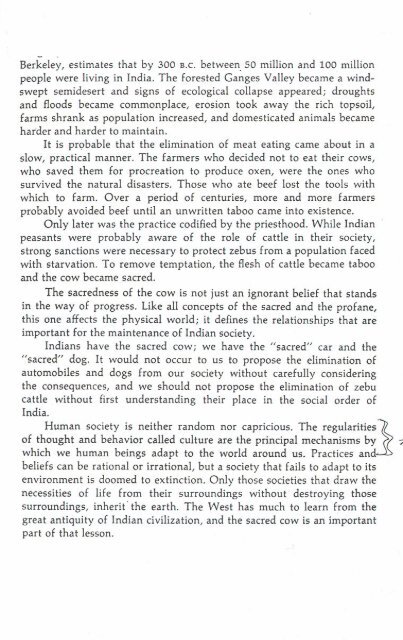India's sacred cow
India's sacred cow
India's sacred cow
You also want an ePaper? Increase the reach of your titles
YUMPU automatically turns print PDFs into web optimized ePapers that Google loves.
Berkeley, estimates that by 300 B.C.between. 50 million and 100 million<br />
people were living in India. The forested Ganges Valley became a windswept<br />
semidesert and signs of ecological collapse appeared; droughts<br />
and floods became commonplace, erosion took away the rich topsoil,<br />
farms shrank as population increased, and domesticated animals became<br />
harder and harder to maintain.<br />
It is probable that the elimination of meat eating came about in a<br />
slow, practical manner. The farmers who decided not to eat their <strong>cow</strong>s,<br />
who saved them for procreation to produce oxen, were the ones who<br />
survived the natural disasters. Those who ate beef lost the tools with<br />
which to farm. Over a period of centuries, more and more farmers<br />
probably avoided beef until an unwritten taboo came into existence.<br />
Only later was the practice codified by the priesthood. While Indian<br />
peasants were probably aware of the role of cattle in their society,<br />
strong sanctions were necessary to protect zebus from a population faced<br />
with starvation. To remove temptation, the flesh of cattle became taboo<br />
and the <strong>cow</strong> became <strong>sacred</strong>.<br />
The <strong>sacred</strong>ness of the <strong>cow</strong> is not just an ignorant belief that stands<br />
in the way of progress. Like all concepts of the <strong>sacred</strong> and the profane,<br />
this one affects the physical world; it defines the relationships<br />
important for the maintenance of Indian society.<br />
that are<br />
Indians have the <strong>sacred</strong> <strong>cow</strong>; we have the "<strong>sacred</strong>" car and the<br />
"<strong>sacred</strong>" dog. It would not occur to us to propose the elimination of<br />
automobiles and dogs from our society without carefully considering<br />
the consequences, and we should not propose the elimination of zebu<br />
cattle<br />
India.<br />
without first understanding their place in the social order of<br />
Human society is neither random nor capricious. The regUlarities<br />
}<br />
of thought and behavior called culture are the principal mechanisms by :;<br />
which we human beings adapt to the world around us. Practices and<br />
beliefs can be rational or irrational, but a society that fails to adapt to its<br />
environment is doomed to extinction. Only those societies that draw the<br />
necessities of life from their surroundings without destroying those<br />
surroundings, inherit'the earth. The West has much to learn from the<br />
great antiquity of Indian civilization, and the <strong>sacred</strong> <strong>cow</strong> is an important<br />
part of that lesson.


